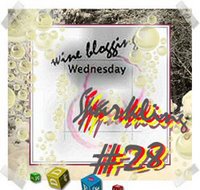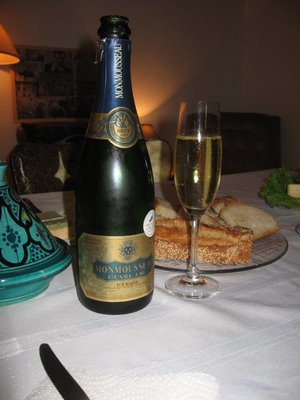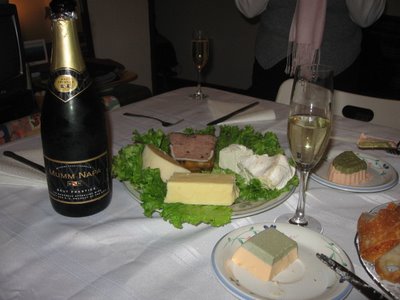
It was a huge pleasure to partake is this substantial (and revealing) tasting of some fine Cabernet Franc wines.
By teaming up with fellow blogger Joe, I was able to stage a worthwhile look at this varietal in two New World and three Old World examples: from Napa Valley's Stags Leap District, from Niagara Peninsula's Glenlake Vineyard and three from Loire appellations, including Thierry Germain's Domaine des Roches Neuves cuvée La Marginale, which sadly is no longer available for sale in Quebec.
Thanks to Joe for extracting that bottle from his cellar. He also brought the Napa Cab produced by Steltzner Vineyards. I provided the Chinon and Niagara wines, plus a unique Loire red blend from Vincent Girault at Château Gaillard in Mesland, just to get our tasting hats on. Here's how I saw it all go down.
Château Gaillard Vieilles Vignes Touraine-Mesland 2000
This wine was not tasted blind. It was, as I mentioned, our warm-up wine. From the 2000 vintage, this has got to be the cheapest oldest wine you can buy at the SAQ. Adding to the intrigue was a percentage Gamay that the winemaker claimed to blend into this seven-year-old version of Cabernet Franc. How would this taste? A lot like Malbec actually, and that's of course because Côt was the third blending grape involved, perhaps the primary one. The Gamay provided a squelch of fruity tartness, the Cabernet seemed to add some rich cocoa notes. But it mostly seemed to be an expression most characteristic of Malbec or Gamay than Cabernet. (Several nights later this wine is still hanging on nicely with some zip). For $19, this bottle from 2000 is a rather odd delivery of an otherwise friendly and fun quaffer.
Château Gaillard: Certified organic and biodynamic. Vincent Girault, Mesland, Loir et Cher, France. 12%.
Charles Joguet Clos du Chêne Vert Chinon 2002
To me this was tell-tale Chinon, and the easiest to separate from the rest of the wines. It was decanted and definitely needs it. Even after a half-hour, it was still settling in. On the nose I first got cassis and cream. It seemed one-note on the palate, but that was still changing in the glass. On the palate it became less strict, offering luscious notes of tomato and green pepper. It is a typically vegetal wine with strong earthy/mineral elements so it's not surprising it goes so well with food. When I served beef tenderloin, seasoned potatoes wedges and garlic-steamed broccoli (which, perhaps unfortunately, only occurred after the wines were revealed), this Cabernet really showed its stuff. It ushered in the meal like none of the others, a perfect partner for steak and frites or for simmered beef and fresh vegetables. (I think that only food with really spicy or sweet elements would prevent this wine from shining as bright -- this wine definitely has a style shared with the ultimate dining wines.)
Clos du Chêne Vert: Charles Joguet, Sazilly, France. 12.5%.
Thierry Germain Domaine des Roches Neuves La Marginale Saumur Champigny 2003
This was the first wine we decanted and the first wine I tasted blind. By the time I stopped taking notes it was still baffling me, especially as to its true potential. This wine was so solid with so much depth that I felt the best reading on what this wine really amounts to could only come years down the road. It had a sharp nose rendering a complex bouquet. On the palate it was equally complex and powerful. The finish delivers admirably huge tannins -- definitely an aspect worth revisiting in the future. If it was a bit tight in the early stages, a palpable acidity was shown so I see no reason why it wouldn't last a decade or more. The fruit reminded me of Saumur fruit and terroir, though with many times the body and many times the lift. Ultimately, this convinced me that it was the other French wine, though clearly more New World-ish than the Chinon. A revelation -- but it manhandled my meal a bit. If only I could save my dinner and then reheat it with this wine ten years from now.
La Marginale: Thierry Germain, Varrains, France. 13%.
Steltzner Vineyards Stags Leap District Napa Valley 2004
Here is where I lost my way. The nose of this wine presented grenadine and spices and a somewhat understated aroma of leather. This was soft and alluring and was channeling the French wines I drink almost every night. On the palate, it was sweetish and offered less intrigue than the nose. It was more heavily oaked and yet much lighter than the Marginale -- which is a far from ideal combination. Especially with food, it ends up generating vanilla and so it comes off cloying. You might sense that it has peaked and is already receding. So my guess was that this was the 2000 Niagara wine rather than the Napa three-year-old. I was wrong. Surprise! I really could not tell at all that this was an over-alcoholized American wine of 15%. Credit to Steltzner, though as the night went on and I revisited it after dessert the alcohol was suddenly unmasked. The Napa zap! But too late -- I was fooled. To me this was the most demure and attractive nose of the bunch but it took me spiraling downhill from there. If I had it again, I wouldn't decant.
Steltzner: Napa, California, U.S.A. 15%.
Hillebrand Estates Glenlake Vineyards Showcase Niagara Peninsula 2000
Alcoholized and highly evolved in the glass, despite not decanting this bottle. This wine is oxidized and was rebottled for return.
This post mirrors what Joe already published over on Joe's Wine. But unlike Joe, I am not including my notes for the Niagara bottle (and I instead mentioned the Gaillard, even though it was not tasted blind). I'm taking the Niagara wine back. This is my decision. Joe wrote me that he "didn't find it to be something that needs returning," but he understood my feelings. The fact is I had tasted the Niagara wine earlier this year and wrote glowing notes on it here. But it showed up at our tasting showing seriously aged fruit and oxidation and this was merely a matter of weeks after purchase from the winery. How disappointing.
MY LESSONS LEARNED
But I think my real disappointment was that during our tasting's blind phase, I didn't guess correctly. I observed yet I let a favourable memory of the Niagara bottle and a distaste of American wine dictate my guesses. This was because I mistook the strength of oxidizing elements on the nose for the presence of high levels of alcohol. I was shocked to see this actually revealed as Niagara. It made prefect sense to the neutral bystander, and in hindsight. This wine was much older, and had my observations been interpreted correctly, I was there. But I was swayed despite -- perhaps paradoxically because of -- the fact that we were doing them blind.
Lesson 1: Blind tastings are best performed on bottles that you have not tasted before or you'll be tempted to outsmart your own blind observations with memory and personal response, which is quite disappointing because it defeats the whole purpose.
Or rather, in blind testings, it's best to forget the past. I think my tasting partner Joe had a firm handle on this aspect. He had tasted the Steltzner before. Experience is knowledge but it's synthesized knowledge -- be advised to leave out individual bottles experiences!
"No need to be disappointed," said Joe in the postmortem. "It shows that the blind worked, and you correctly separated the old world from the new." [It's true I did ID this and the other French wines correctly].
"The Canuck wine was a bit tired -- Cab Franc, probably from younger vines than all of the others, is not going to keep forever... note that the bottle to bottle variability probably increases over time. Your previous experience was eight months ago at the end of a wine's life -- perhaps not that much of a surprise they were quite different?" surmised Joe.
OTHER LESSON LEARNED
Lesson 2: Is it hard to keep track of wine consumption at a blind tasting while it is happening! I don't think I'll ever figure out a way to better keep track when there's so much set before me. Perhaps proper tasting glasses would help?
Lesson 3: Blind tastings with "table talk" can sway evaluation as much as "drinking the label" does in non-blind tastings. Joe and I had some table talk, but not much. We didn't discuss conclusions until the end. And besides, what little table talk there was had almost no effect since the wines were positioned blind as well as tasted blind. This prevented a shared order of wines between to the two of us so table talk comments could not be attributed to a particular wine and therefore sway tasting opinions.
Lesson 4: I did not assess colour in the tasting because I thought it would too easily reveal the wine, given the broad four-year gap in cuvée vintages. The lighting was also poor so I let Joe turn up the house lights while I put the final touches on dinner (see Joe's notes for proper scoring). But the fact is that the wines' colour didn't reveal much at all, no matter how hard I tried to read them.
 Château Montelena Chardonnay Napa Valley 2005
Château Montelena Chardonnay Napa Valley 2005












